Exploring Wider Professional Practice & Development in Education
VerifiedAdded on 2023/06/11
|8
|2342
|246
Report
AI Summary
This report explores wider professional practice and development within the context of education and training. It defines professionalism and dual professionalism, emphasizing the core values that shape educators. The report discusses the impact of social, economic, and political factors on education, along with the importance of policies, codes of conduct, and guidelines. It examines the roles of stakeholders in education, including administrators, teachers, families, and community members, and how their involvement can improve curriculum and standards. The report also addresses the development of effective curricula, quality assurance in education and training, and the significance of self-evaluation at both individual and institutional levels. Finally, it outlines methods for program evaluation, focusing on setting explicit goals, measuring program impact, and interpreting results, highlighting areas for improvement in application and time management to enhance learning outcomes. Desklib provides access to similar solved assignments for students.
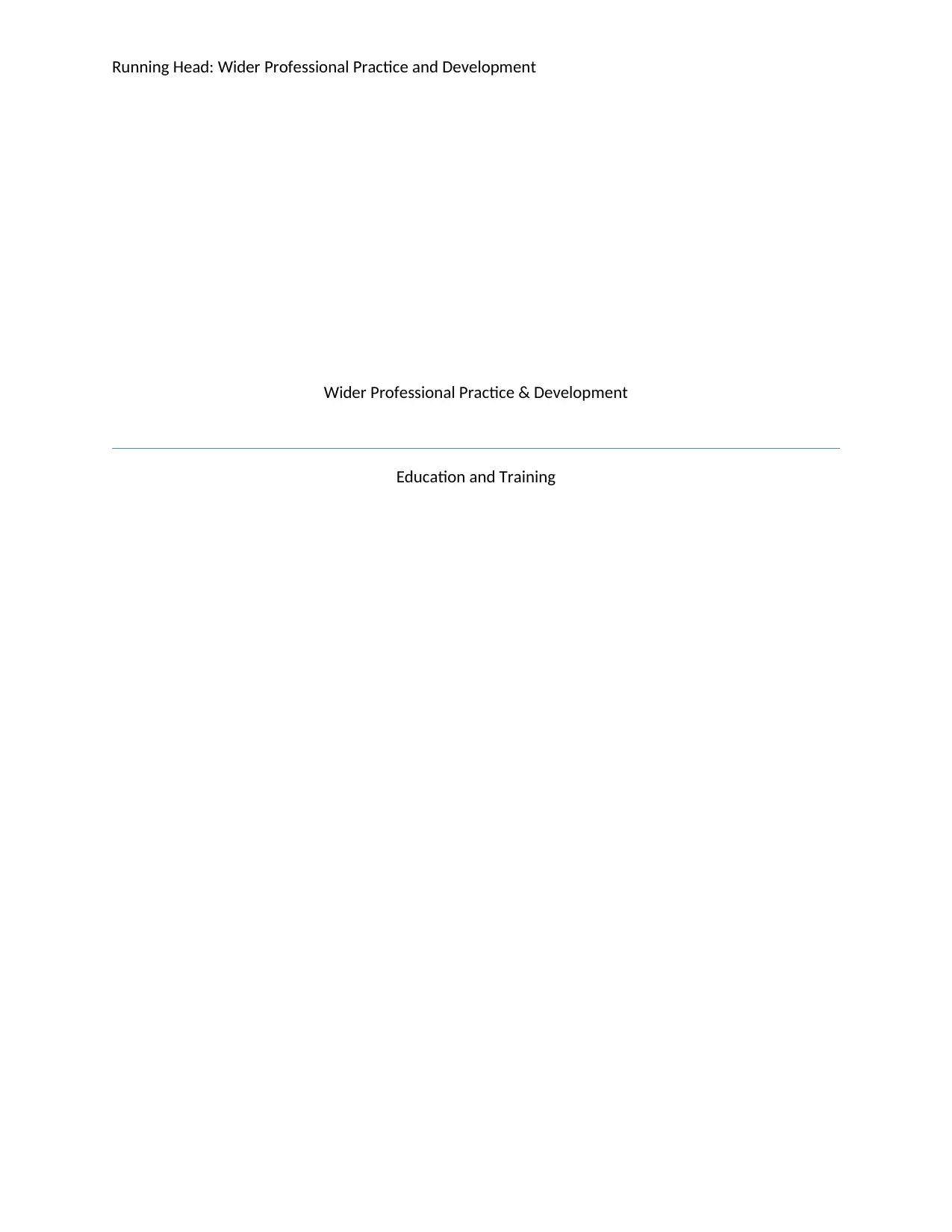
Running Head: Wider Professional Practice and Development
Wider Professional Practice & Development
Education and Training
Wider Professional Practice & Development
Education and Training
Paraphrase This Document
Need a fresh take? Get an instant paraphrase of this document with our AI Paraphraser
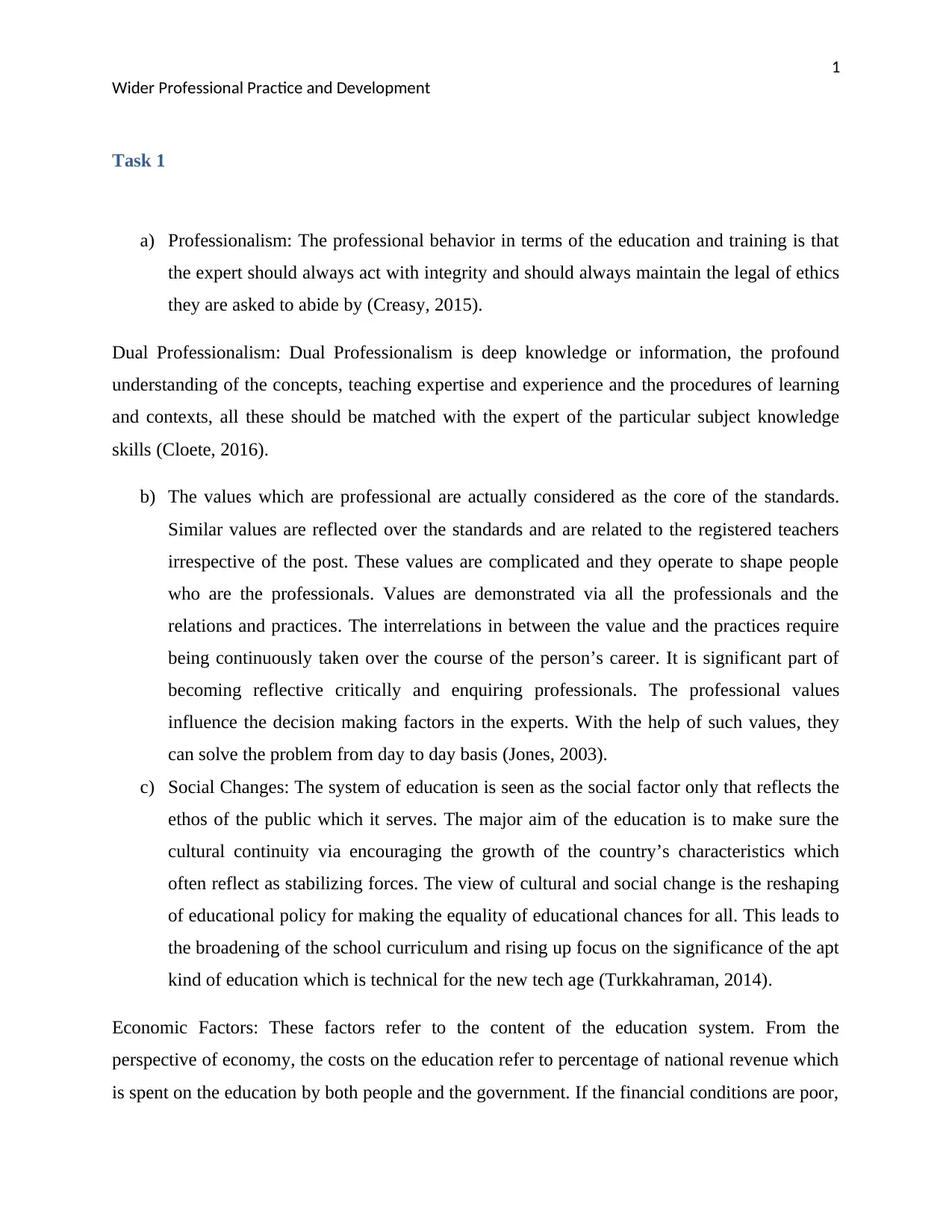
1
Wider Professional Practice and Development
Task 1
a) Professionalism: The professional behavior in terms of the education and training is that
the expert should always act with integrity and should always maintain the legal of ethics
they are asked to abide by (Creasy, 2015).
Dual Professionalism: Dual Professionalism is deep knowledge or information, the profound
understanding of the concepts, teaching expertise and experience and the procedures of learning
and contexts, all these should be matched with the expert of the particular subject knowledge
skills (Cloete, 2016).
b) The values which are professional are actually considered as the core of the standards.
Similar values are reflected over the standards and are related to the registered teachers
irrespective of the post. These values are complicated and they operate to shape people
who are the professionals. Values are demonstrated via all the professionals and the
relations and practices. The interrelations in between the value and the practices require
being continuously taken over the course of the person’s career. It is significant part of
becoming reflective critically and enquiring professionals. The professional values
influence the decision making factors in the experts. With the help of such values, they
can solve the problem from day to day basis (Jones, 2003).
c) Social Changes: The system of education is seen as the social factor only that reflects the
ethos of the public which it serves. The major aim of the education is to make sure the
cultural continuity via encouraging the growth of the country’s characteristics which
often reflect as stabilizing forces. The view of cultural and social change is the reshaping
of educational policy for making the equality of educational chances for all. This leads to
the broadening of the school curriculum and rising up focus on the significance of the apt
kind of education which is technical for the new tech age (Turkkahraman, 2014).
Economic Factors: These factors refer to the content of the education system. From the
perspective of economy, the costs on the education refer to percentage of national revenue which
is spent on the education by both people and the government. If the financial conditions are poor,
Wider Professional Practice and Development
Task 1
a) Professionalism: The professional behavior in terms of the education and training is that
the expert should always act with integrity and should always maintain the legal of ethics
they are asked to abide by (Creasy, 2015).
Dual Professionalism: Dual Professionalism is deep knowledge or information, the profound
understanding of the concepts, teaching expertise and experience and the procedures of learning
and contexts, all these should be matched with the expert of the particular subject knowledge
skills (Cloete, 2016).
b) The values which are professional are actually considered as the core of the standards.
Similar values are reflected over the standards and are related to the registered teachers
irrespective of the post. These values are complicated and they operate to shape people
who are the professionals. Values are demonstrated via all the professionals and the
relations and practices. The interrelations in between the value and the practices require
being continuously taken over the course of the person’s career. It is significant part of
becoming reflective critically and enquiring professionals. The professional values
influence the decision making factors in the experts. With the help of such values, they
can solve the problem from day to day basis (Jones, 2003).
c) Social Changes: The system of education is seen as the social factor only that reflects the
ethos of the public which it serves. The major aim of the education is to make sure the
cultural continuity via encouraging the growth of the country’s characteristics which
often reflect as stabilizing forces. The view of cultural and social change is the reshaping
of educational policy for making the equality of educational chances for all. This leads to
the broadening of the school curriculum and rising up focus on the significance of the apt
kind of education which is technical for the new tech age (Turkkahraman, 2014).
Economic Factors: These factors refer to the content of the education system. From the
perspective of economy, the costs on the education refer to percentage of national revenue which
is spent on the education by both people and the government. If the financial conditions are poor,
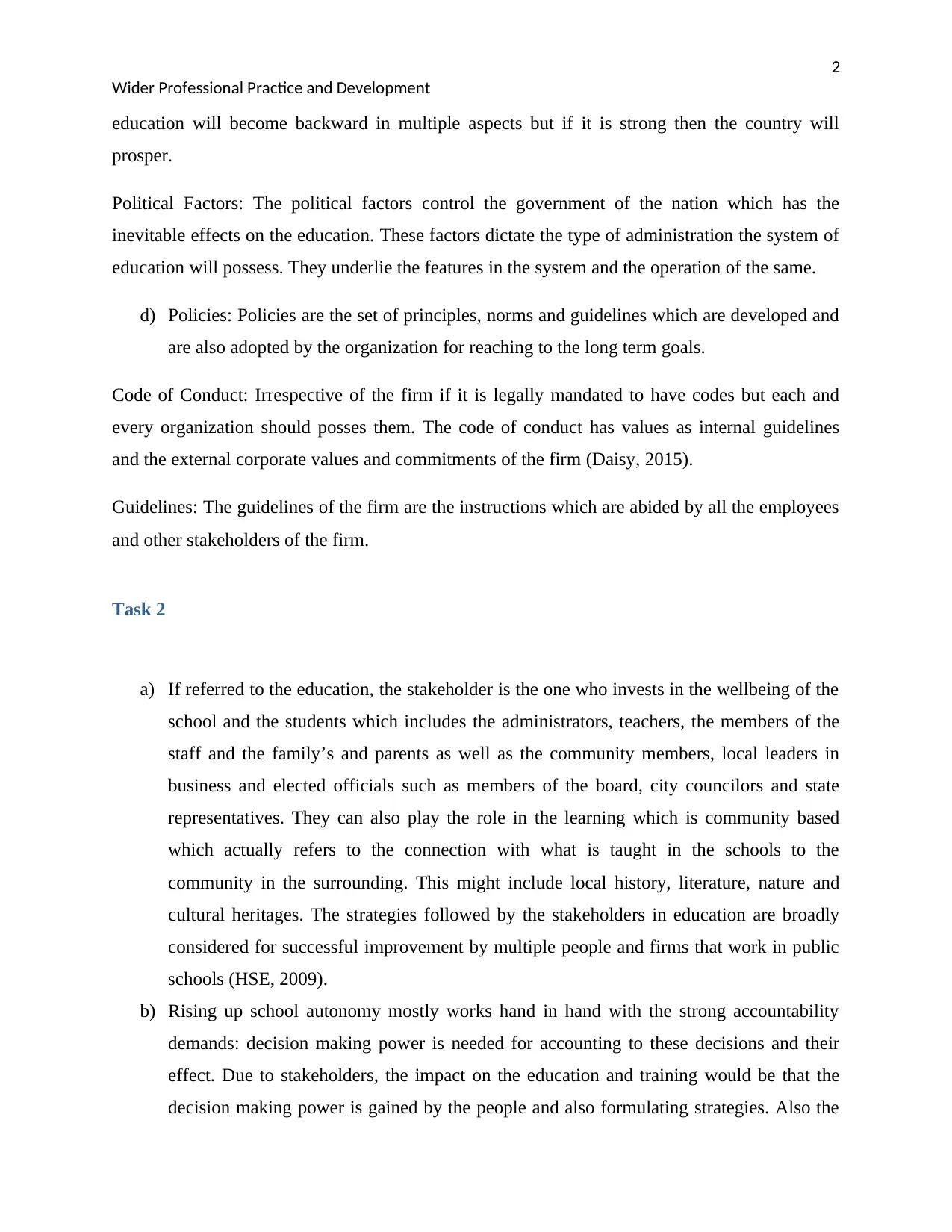
2
Wider Professional Practice and Development
education will become backward in multiple aspects but if it is strong then the country will
prosper.
Political Factors: The political factors control the government of the nation which has the
inevitable effects on the education. These factors dictate the type of administration the system of
education will possess. They underlie the features in the system and the operation of the same.
d) Policies: Policies are the set of principles, norms and guidelines which are developed and
are also adopted by the organization for reaching to the long term goals.
Code of Conduct: Irrespective of the firm if it is legally mandated to have codes but each and
every organization should posses them. The code of conduct has values as internal guidelines
and the external corporate values and commitments of the firm (Daisy, 2015).
Guidelines: The guidelines of the firm are the instructions which are abided by all the employees
and other stakeholders of the firm.
Task 2
a) If referred to the education, the stakeholder is the one who invests in the wellbeing of the
school and the students which includes the administrators, teachers, the members of the
staff and the family’s and parents as well as the community members, local leaders in
business and elected officials such as members of the board, city councilors and state
representatives. They can also play the role in the learning which is community based
which actually refers to the connection with what is taught in the schools to the
community in the surrounding. This might include local history, literature, nature and
cultural heritages. The strategies followed by the stakeholders in education are broadly
considered for successful improvement by multiple people and firms that work in public
schools (HSE, 2009).
b) Rising up school autonomy mostly works hand in hand with the strong accountability
demands: decision making power is needed for accounting to these decisions and their
effect. Due to stakeholders, the impact on the education and training would be that the
decision making power is gained by the people and also formulating strategies. Also the
Wider Professional Practice and Development
education will become backward in multiple aspects but if it is strong then the country will
prosper.
Political Factors: The political factors control the government of the nation which has the
inevitable effects on the education. These factors dictate the type of administration the system of
education will possess. They underlie the features in the system and the operation of the same.
d) Policies: Policies are the set of principles, norms and guidelines which are developed and
are also adopted by the organization for reaching to the long term goals.
Code of Conduct: Irrespective of the firm if it is legally mandated to have codes but each and
every organization should posses them. The code of conduct has values as internal guidelines
and the external corporate values and commitments of the firm (Daisy, 2015).
Guidelines: The guidelines of the firm are the instructions which are abided by all the employees
and other stakeholders of the firm.
Task 2
a) If referred to the education, the stakeholder is the one who invests in the wellbeing of the
school and the students which includes the administrators, teachers, the members of the
staff and the family’s and parents as well as the community members, local leaders in
business and elected officials such as members of the board, city councilors and state
representatives. They can also play the role in the learning which is community based
which actually refers to the connection with what is taught in the schools to the
community in the surrounding. This might include local history, literature, nature and
cultural heritages. The strategies followed by the stakeholders in education are broadly
considered for successful improvement by multiple people and firms that work in public
schools (HSE, 2009).
b) Rising up school autonomy mostly works hand in hand with the strong accountability
demands: decision making power is needed for accounting to these decisions and their
effect. Due to stakeholders, the impact on the education and training would be that the
decision making power is gained by the people and also formulating strategies. Also the
⊘ This is a preview!⊘
Do you want full access?
Subscribe today to unlock all pages.

Trusted by 1+ million students worldwide
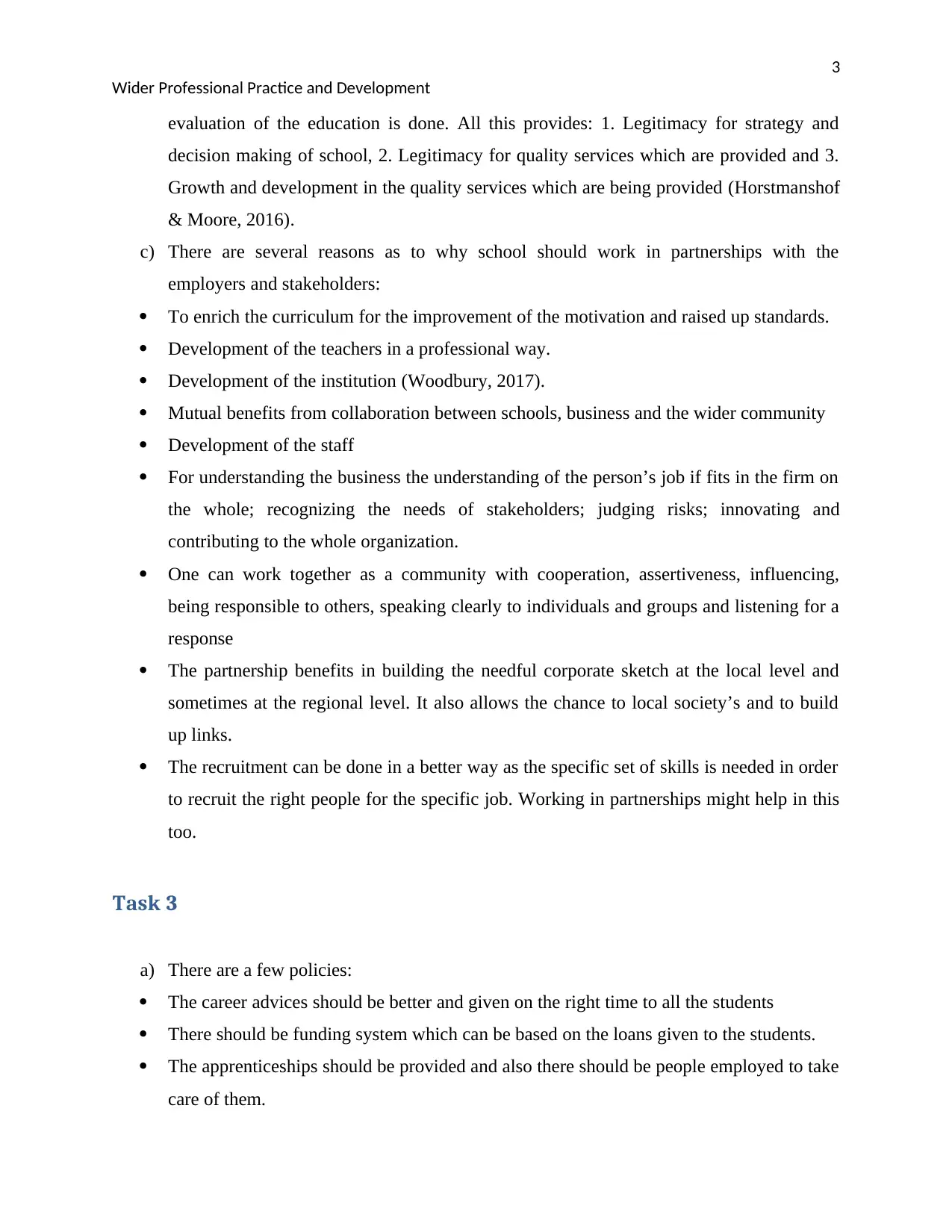
3
Wider Professional Practice and Development
evaluation of the education is done. All this provides: 1. Legitimacy for strategy and
decision making of school, 2. Legitimacy for quality services which are provided and 3.
Growth and development in the quality services which are being provided (Horstmanshof
& Moore, 2016).
c) There are several reasons as to why school should work in partnerships with the
employers and stakeholders:
To enrich the curriculum for the improvement of the motivation and raised up standards.
Development of the teachers in a professional way.
Development of the institution (Woodbury, 2017).
Mutual benefits from collaboration between schools, business and the wider community
Development of the staff
For understanding the business the understanding of the person’s job if fits in the firm on
the whole; recognizing the needs of stakeholders; judging risks; innovating and
contributing to the whole organization.
One can work together as a community with cooperation, assertiveness, influencing,
being responsible to others, speaking clearly to individuals and groups and listening for a
response
The partnership benefits in building the needful corporate sketch at the local level and
sometimes at the regional level. It also allows the chance to local society’s and to build
up links.
The recruitment can be done in a better way as the specific set of skills is needed in order
to recruit the right people for the specific job. Working in partnerships might help in this
too.
Task 3
a) There are a few policies:
The career advices should be better and given on the right time to all the students
There should be funding system which can be based on the loans given to the students.
The apprenticeships should be provided and also there should be people employed to take
care of them.
Wider Professional Practice and Development
evaluation of the education is done. All this provides: 1. Legitimacy for strategy and
decision making of school, 2. Legitimacy for quality services which are provided and 3.
Growth and development in the quality services which are being provided (Horstmanshof
& Moore, 2016).
c) There are several reasons as to why school should work in partnerships with the
employers and stakeholders:
To enrich the curriculum for the improvement of the motivation and raised up standards.
Development of the teachers in a professional way.
Development of the institution (Woodbury, 2017).
Mutual benefits from collaboration between schools, business and the wider community
Development of the staff
For understanding the business the understanding of the person’s job if fits in the firm on
the whole; recognizing the needs of stakeholders; judging risks; innovating and
contributing to the whole organization.
One can work together as a community with cooperation, assertiveness, influencing,
being responsible to others, speaking clearly to individuals and groups and listening for a
response
The partnership benefits in building the needful corporate sketch at the local level and
sometimes at the regional level. It also allows the chance to local society’s and to build
up links.
The recruitment can be done in a better way as the specific set of skills is needed in order
to recruit the right people for the specific job. Working in partnerships might help in this
too.
Task 3
a) There are a few policies:
The career advices should be better and given on the right time to all the students
There should be funding system which can be based on the loans given to the students.
The apprenticeships should be provided and also there should be people employed to take
care of them.
Paraphrase This Document
Need a fresh take? Get an instant paraphrase of this document with our AI Paraphraser
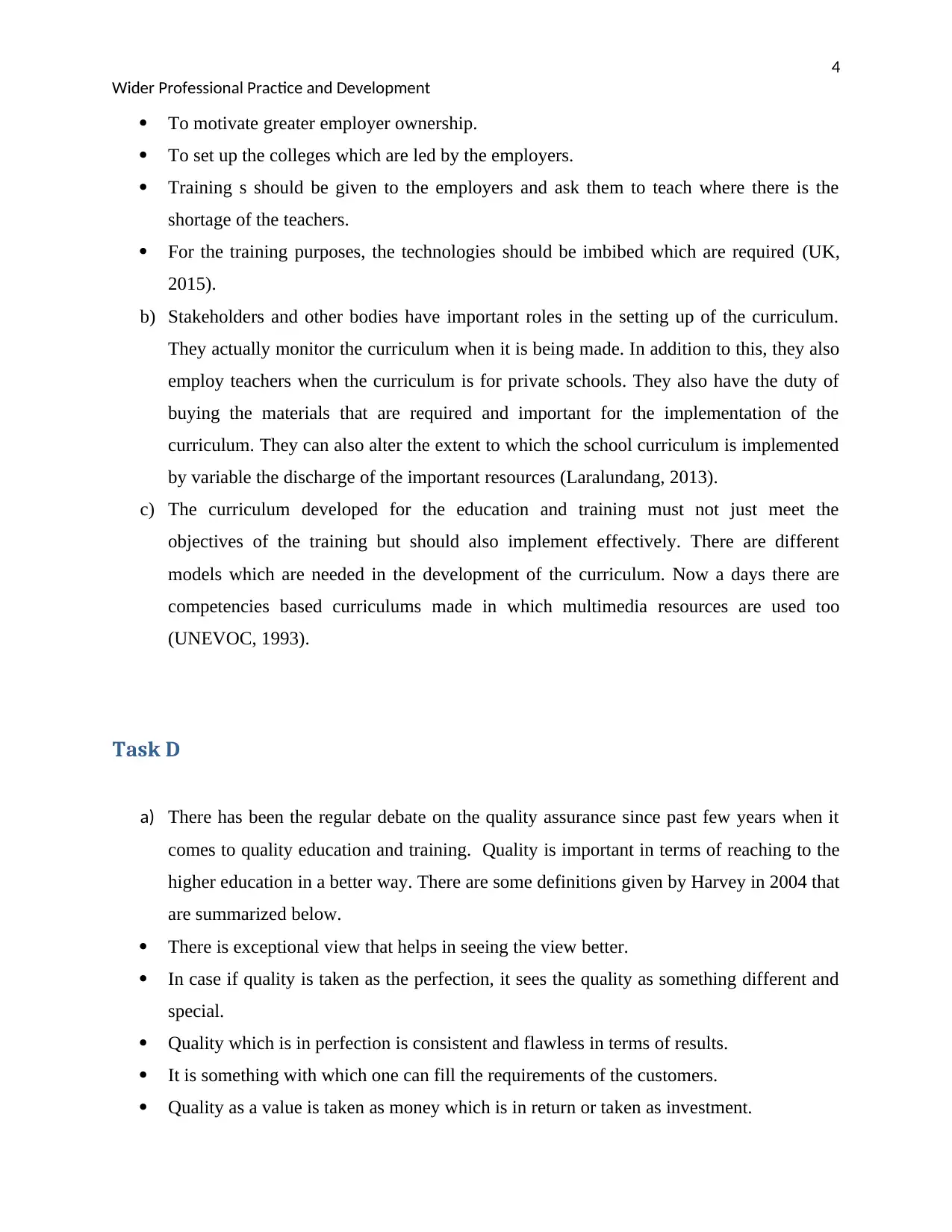
4
Wider Professional Practice and Development
To motivate greater employer ownership.
To set up the colleges which are led by the employers.
Training s should be given to the employers and ask them to teach where there is the
shortage of the teachers.
For the training purposes, the technologies should be imbibed which are required (UK,
2015).
b) Stakeholders and other bodies have important roles in the setting up of the curriculum.
They actually monitor the curriculum when it is being made. In addition to this, they also
employ teachers when the curriculum is for private schools. They also have the duty of
buying the materials that are required and important for the implementation of the
curriculum. They can also alter the extent to which the school curriculum is implemented
by variable the discharge of the important resources (Laralundang, 2013).
c) The curriculum developed for the education and training must not just meet the
objectives of the training but should also implement effectively. There are different
models which are needed in the development of the curriculum. Now a days there are
competencies based curriculums made in which multimedia resources are used too
(UNEVOC, 1993).
Task D
a) There has been the regular debate on the quality assurance since past few years when it
comes to quality education and training. Quality is important in terms of reaching to the
higher education in a better way. There are some definitions given by Harvey in 2004 that
are summarized below.
There is exceptional view that helps in seeing the view better.
In case if quality is taken as the perfection, it sees the quality as something different and
special.
Quality which is in perfection is consistent and flawless in terms of results.
It is something with which one can fill the requirements of the customers.
Quality as a value is taken as money which is in return or taken as investment.
Wider Professional Practice and Development
To motivate greater employer ownership.
To set up the colleges which are led by the employers.
Training s should be given to the employers and ask them to teach where there is the
shortage of the teachers.
For the training purposes, the technologies should be imbibed which are required (UK,
2015).
b) Stakeholders and other bodies have important roles in the setting up of the curriculum.
They actually monitor the curriculum when it is being made. In addition to this, they also
employ teachers when the curriculum is for private schools. They also have the duty of
buying the materials that are required and important for the implementation of the
curriculum. They can also alter the extent to which the school curriculum is implemented
by variable the discharge of the important resources (Laralundang, 2013).
c) The curriculum developed for the education and training must not just meet the
objectives of the training but should also implement effectively. There are different
models which are needed in the development of the curriculum. Now a days there are
competencies based curriculums made in which multimedia resources are used too
(UNEVOC, 1993).
Task D
a) There has been the regular debate on the quality assurance since past few years when it
comes to quality education and training. Quality is important in terms of reaching to the
higher education in a better way. There are some definitions given by Harvey in 2004 that
are summarized below.
There is exceptional view that helps in seeing the view better.
In case if quality is taken as the perfection, it sees the quality as something different and
special.
Quality which is in perfection is consistent and flawless in terms of results.
It is something with which one can fill the requirements of the customers.
Quality as a value is taken as money which is in return or taken as investment.
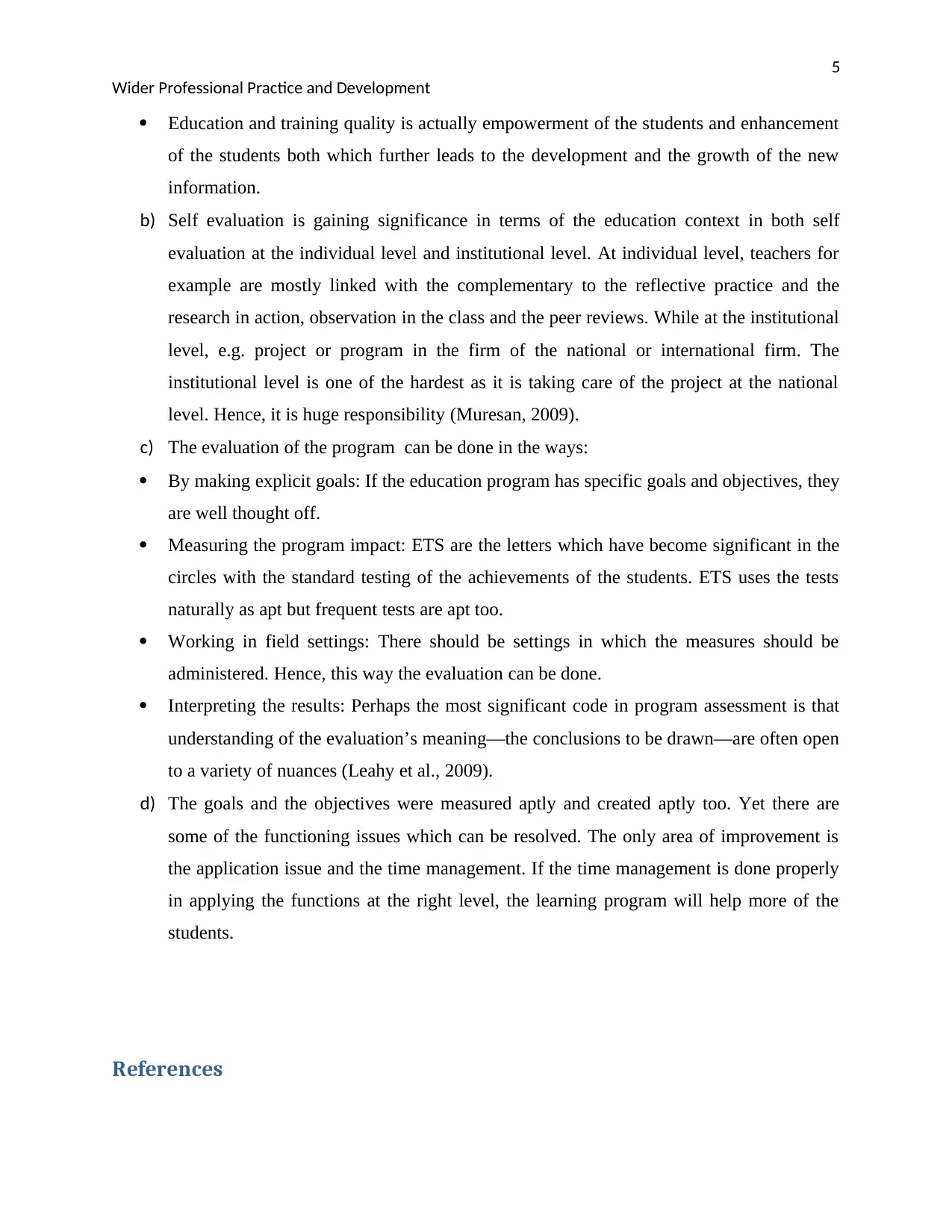
5
Wider Professional Practice and Development
Education and training quality is actually empowerment of the students and enhancement
of the students both which further leads to the development and the growth of the new
information.
b) Self evaluation is gaining significance in terms of the education context in both self
evaluation at the individual level and institutional level. At individual level, teachers for
example are mostly linked with the complementary to the reflective practice and the
research in action, observation in the class and the peer reviews. While at the institutional
level, e.g. project or program in the firm of the national or international firm. The
institutional level is one of the hardest as it is taking care of the project at the national
level. Hence, it is huge responsibility (Muresan, 2009).
c) The evaluation of the program can be done in the ways:
By making explicit goals: If the education program has specific goals and objectives, they
are well thought off.
Measuring the program impact: ETS are the letters which have become significant in the
circles with the standard testing of the achievements of the students. ETS uses the tests
naturally as apt but frequent tests are apt too.
Working in field settings: There should be settings in which the measures should be
administered. Hence, this way the evaluation can be done.
Interpreting the results: Perhaps the most significant code in program assessment is that
understanding of the evaluation’s meaning—the conclusions to be drawn—are often open
to a variety of nuances (Leahy et al., 2009).
d) The goals and the objectives were measured aptly and created aptly too. Yet there are
some of the functioning issues which can be resolved. The only area of improvement is
the application issue and the time management. If the time management is done properly
in applying the functions at the right level, the learning program will help more of the
students.
References
Wider Professional Practice and Development
Education and training quality is actually empowerment of the students and enhancement
of the students both which further leads to the development and the growth of the new
information.
b) Self evaluation is gaining significance in terms of the education context in both self
evaluation at the individual level and institutional level. At individual level, teachers for
example are mostly linked with the complementary to the reflective practice and the
research in action, observation in the class and the peer reviews. While at the institutional
level, e.g. project or program in the firm of the national or international firm. The
institutional level is one of the hardest as it is taking care of the project at the national
level. Hence, it is huge responsibility (Muresan, 2009).
c) The evaluation of the program can be done in the ways:
By making explicit goals: If the education program has specific goals and objectives, they
are well thought off.
Measuring the program impact: ETS are the letters which have become significant in the
circles with the standard testing of the achievements of the students. ETS uses the tests
naturally as apt but frequent tests are apt too.
Working in field settings: There should be settings in which the measures should be
administered. Hence, this way the evaluation can be done.
Interpreting the results: Perhaps the most significant code in program assessment is that
understanding of the evaluation’s meaning—the conclusions to be drawn—are often open
to a variety of nuances (Leahy et al., 2009).
d) The goals and the objectives were measured aptly and created aptly too. Yet there are
some of the functioning issues which can be resolved. The only area of improvement is
the application issue and the time management. If the time management is done properly
in applying the functions at the right level, the learning program will help more of the
students.
References
⊘ This is a preview!⊘
Do you want full access?
Subscribe today to unlock all pages.

Trusted by 1+ million students worldwide
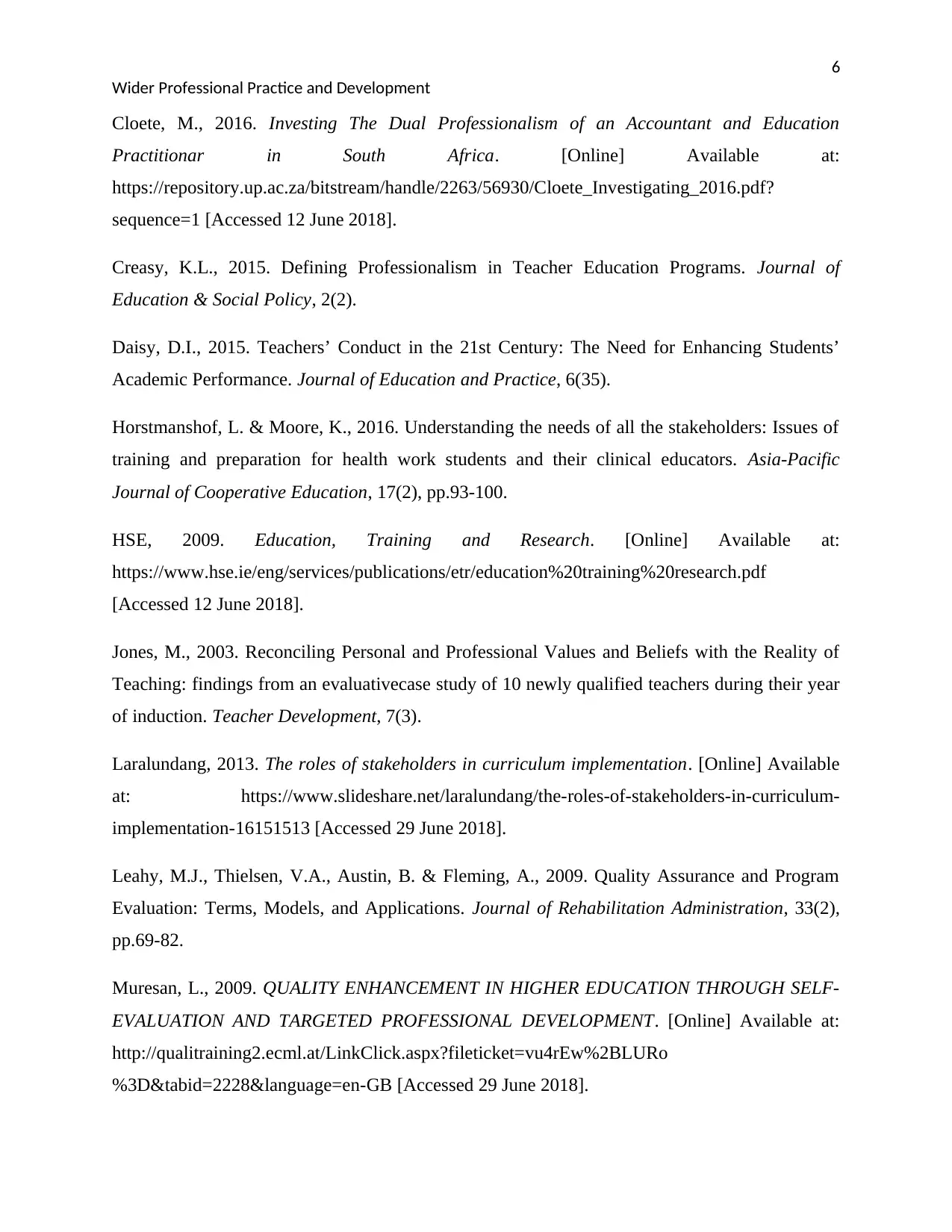
6
Wider Professional Practice and Development
Cloete, M., 2016. Investing The Dual Professionalism of an Accountant and Education
Practitionar in South Africa. [Online] Available at:
https://repository.up.ac.za/bitstream/handle/2263/56930/Cloete_Investigating_2016.pdf?
sequence=1 [Accessed 12 June 2018].
Creasy, K.L., 2015. Defining Professionalism in Teacher Education Programs. Journal of
Education & Social Policy, 2(2).
Daisy, D.I., 2015. Teachers’ Conduct in the 21st Century: The Need for Enhancing Students’
Academic Performance. Journal of Education and Practice, 6(35).
Horstmanshof, L. & Moore, K., 2016. Understanding the needs of all the stakeholders: Issues of
training and preparation for health work students and their clinical educators. Asia-Pacific
Journal of Cooperative Education, 17(2), pp.93-100.
HSE, 2009. Education, Training and Research. [Online] Available at:
https://www.hse.ie/eng/services/publications/etr/education%20training%20research.pdf
[Accessed 12 June 2018].
Jones, M., 2003. Reconciling Personal and Professional Values and Beliefs with the Reality of
Teaching: findings from an evaluativecase study of 10 newly qualified teachers during their year
of induction. Teacher Development, 7(3).
Laralundang, 2013. The roles of stakeholders in curriculum implementation. [Online] Available
at: https://www.slideshare.net/laralundang/the-roles-of-stakeholders-in-curriculum-
implementation-16151513 [Accessed 29 June 2018].
Leahy, M.J., Thielsen, V.A., Austin, B. & Fleming, A., 2009. Quality Assurance and Program
Evaluation: Terms, Models, and Applications. Journal of Rehabilitation Administration, 33(2),
pp.69-82.
Muresan, L., 2009. QUALITY ENHANCEMENT IN HIGHER EDUCATION THROUGH SELF-
EVALUATION AND TARGETED PROFESSIONAL DEVELOPMENT. [Online] Available at:
http://qualitraining2.ecml.at/LinkClick.aspx?fileticket=vu4rEw%2BLURo
%3D&tabid=2228&language=en-GB [Accessed 29 June 2018].
Wider Professional Practice and Development
Cloete, M., 2016. Investing The Dual Professionalism of an Accountant and Education
Practitionar in South Africa. [Online] Available at:
https://repository.up.ac.za/bitstream/handle/2263/56930/Cloete_Investigating_2016.pdf?
sequence=1 [Accessed 12 June 2018].
Creasy, K.L., 2015. Defining Professionalism in Teacher Education Programs. Journal of
Education & Social Policy, 2(2).
Daisy, D.I., 2015. Teachers’ Conduct in the 21st Century: The Need for Enhancing Students’
Academic Performance. Journal of Education and Practice, 6(35).
Horstmanshof, L. & Moore, K., 2016. Understanding the needs of all the stakeholders: Issues of
training and preparation for health work students and their clinical educators. Asia-Pacific
Journal of Cooperative Education, 17(2), pp.93-100.
HSE, 2009. Education, Training and Research. [Online] Available at:
https://www.hse.ie/eng/services/publications/etr/education%20training%20research.pdf
[Accessed 12 June 2018].
Jones, M., 2003. Reconciling Personal and Professional Values and Beliefs with the Reality of
Teaching: findings from an evaluativecase study of 10 newly qualified teachers during their year
of induction. Teacher Development, 7(3).
Laralundang, 2013. The roles of stakeholders in curriculum implementation. [Online] Available
at: https://www.slideshare.net/laralundang/the-roles-of-stakeholders-in-curriculum-
implementation-16151513 [Accessed 29 June 2018].
Leahy, M.J., Thielsen, V.A., Austin, B. & Fleming, A., 2009. Quality Assurance and Program
Evaluation: Terms, Models, and Applications. Journal of Rehabilitation Administration, 33(2),
pp.69-82.
Muresan, L., 2009. QUALITY ENHANCEMENT IN HIGHER EDUCATION THROUGH SELF-
EVALUATION AND TARGETED PROFESSIONAL DEVELOPMENT. [Online] Available at:
http://qualitraining2.ecml.at/LinkClick.aspx?fileticket=vu4rEw%2BLURo
%3D&tabid=2228&language=en-GB [Accessed 29 June 2018].
Paraphrase This Document
Need a fresh take? Get an instant paraphrase of this document with our AI Paraphraser
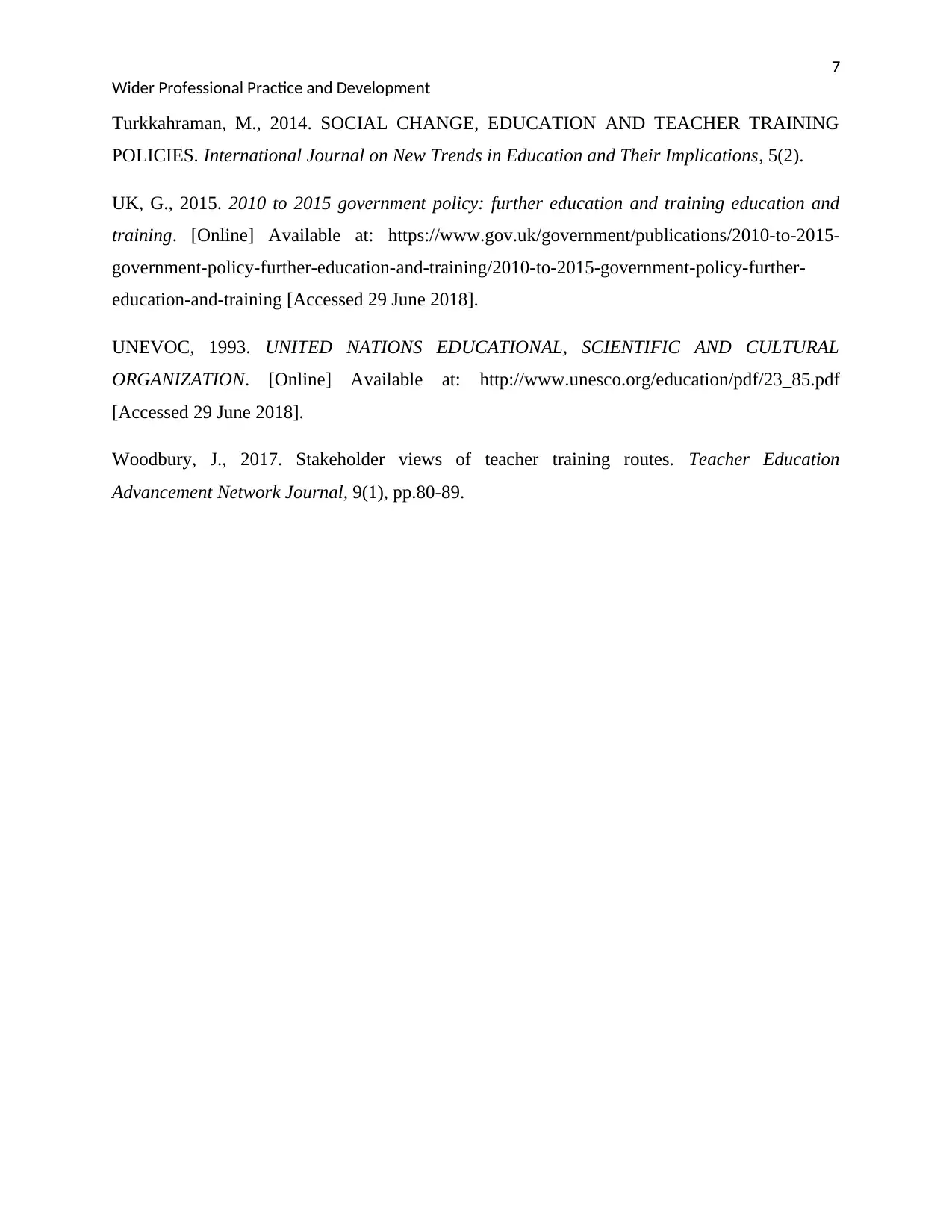
7
Wider Professional Practice and Development
Turkkahraman, M., 2014. SOCIAL CHANGE, EDUCATION AND TEACHER TRAINING
POLICIES. International Journal on New Trends in Education and Their Implications, 5(2).
UK, G., 2015. 2010 to 2015 government policy: further education and training education and
training. [Online] Available at: https://www.gov.uk/government/publications/2010-to-2015-
government-policy-further-education-and-training/2010-to-2015-government-policy-further-
education-and-training [Accessed 29 June 2018].
UNEVOC, 1993. UNITED NATIONS EDUCATIONAL, SCIENTIFIC AND CULTURAL
ORGANIZATION. [Online] Available at: http://www.unesco.org/education/pdf/23_85.pdf
[Accessed 29 June 2018].
Woodbury, J., 2017. Stakeholder views of teacher training routes. Teacher Education
Advancement Network Journal, 9(1), pp.80-89.
Wider Professional Practice and Development
Turkkahraman, M., 2014. SOCIAL CHANGE, EDUCATION AND TEACHER TRAINING
POLICIES. International Journal on New Trends in Education and Their Implications, 5(2).
UK, G., 2015. 2010 to 2015 government policy: further education and training education and
training. [Online] Available at: https://www.gov.uk/government/publications/2010-to-2015-
government-policy-further-education-and-training/2010-to-2015-government-policy-further-
education-and-training [Accessed 29 June 2018].
UNEVOC, 1993. UNITED NATIONS EDUCATIONAL, SCIENTIFIC AND CULTURAL
ORGANIZATION. [Online] Available at: http://www.unesco.org/education/pdf/23_85.pdf
[Accessed 29 June 2018].
Woodbury, J., 2017. Stakeholder views of teacher training routes. Teacher Education
Advancement Network Journal, 9(1), pp.80-89.
1 out of 8
Related Documents
Your All-in-One AI-Powered Toolkit for Academic Success.
+13062052269
info@desklib.com
Available 24*7 on WhatsApp / Email
![[object Object]](/_next/static/media/star-bottom.7253800d.svg)
Unlock your academic potential
Copyright © 2020–2025 A2Z Services. All Rights Reserved. Developed and managed by ZUCOL.



